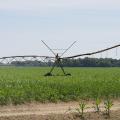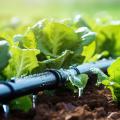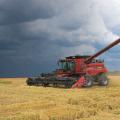Irrigation
Most crops can utilize about 2.5–3 feet of soil profile to extract moisture. This gives a growing plant about 2.5–3.5 inches of available water to carry it without additional rainfall. Emerging crops use very little moisture early in the season, and a good profile of moisture will carry these plants for about a month without supplemental moisture.
As the crops get larger and begin to canopy, a full profile will only last about 8–14 days. This typically begins to occur in early June through August. Rainfall is the best hope for supplemental moisture since it is free, but it is not 100 percent effective. As soils seal over from rain or irrigation, they take water slower, thus making rainfall less effective. Determining how effective a rainfall is should be done with a soil probe, shovel, or some type of device to determine how deep the moisture soaked. Hard, fast rains can run-off as much as 75 percent of the water, where a slow steady rain can soak as much as 90 percent. The type of rainfall event will determine its effectiveness as well as the amount of moisture already in the soil.
Tillage will often dry out the soil surface as deep as 2–3 inches, but doesn't really effect the deeper moisture. Rainfall is the best choice for replenishing the shallow moisture early in the year, but irrigation may be required during the summer months. Supplemental irrigation is not typically needed until mid to late June on most crops under normal rainfall conditions. However, it is never too early to get prepared for irrigation, even if it is early, because it will certainly be needed in July and August to meet crop demand.
Common Conversions:
450 GPM = 1 acre inch per hour or 1 cubic foot per second (cfs)
1 gallon = 8.33 pounds
1 cubic foot = 7.48 gallons = 62.4 pounds
1 acre-inch = 27,000 gallons = 1 acre flooded one inch deep
1 acre-foot = 12 acre-inches = 43,560 cubic feet = 325,900 gallons
1 gallon = 3.785 liters = 0.003785 cubic meters
1 cubic meter = 1000 liters = 264.2 gallons
A column of water 2.31 feet high exerts a pressure at the base of one psi
1 psi = 2.31 feet of vertical elevation change for water.
1 atmosphere = 14.7 psi = 33.95 feet of water
1 inch of mercury = 1.13 feet of water
Publications
News
Water management specialists with Mississippi State University have extensive advice for those implementing different irrigation techniques, but they all agree that using soil moisture sensors is the best way to irrigate.
If there’s one thing that’s important in gardening, it’s proper watering. Vegetable gardens need about 1 inch of water each week.
Success Stories
Brian Andrus irrigated exactly zero times on his Sunflower County farm in 2021. He didn’t even turn on his well.
Delta soybean producer irrigates his fields, increases yields
Most of the Delta is already irrigated, but not all farmers are taking advantage of the latest irrigation technologies. However, agents with the Mississippi State University Extension Service are increasing Delta producers’ knowledge— and application—of new, more efficient ways to water the rows.
Delta farmer Travis Satterfield reflects on 40+ years in the fields
The price of rice hasn’t increased much since Travis Satterfield of Benoit began growing it in 1974, but nearly everything else in the world of production agriculture has changed.








